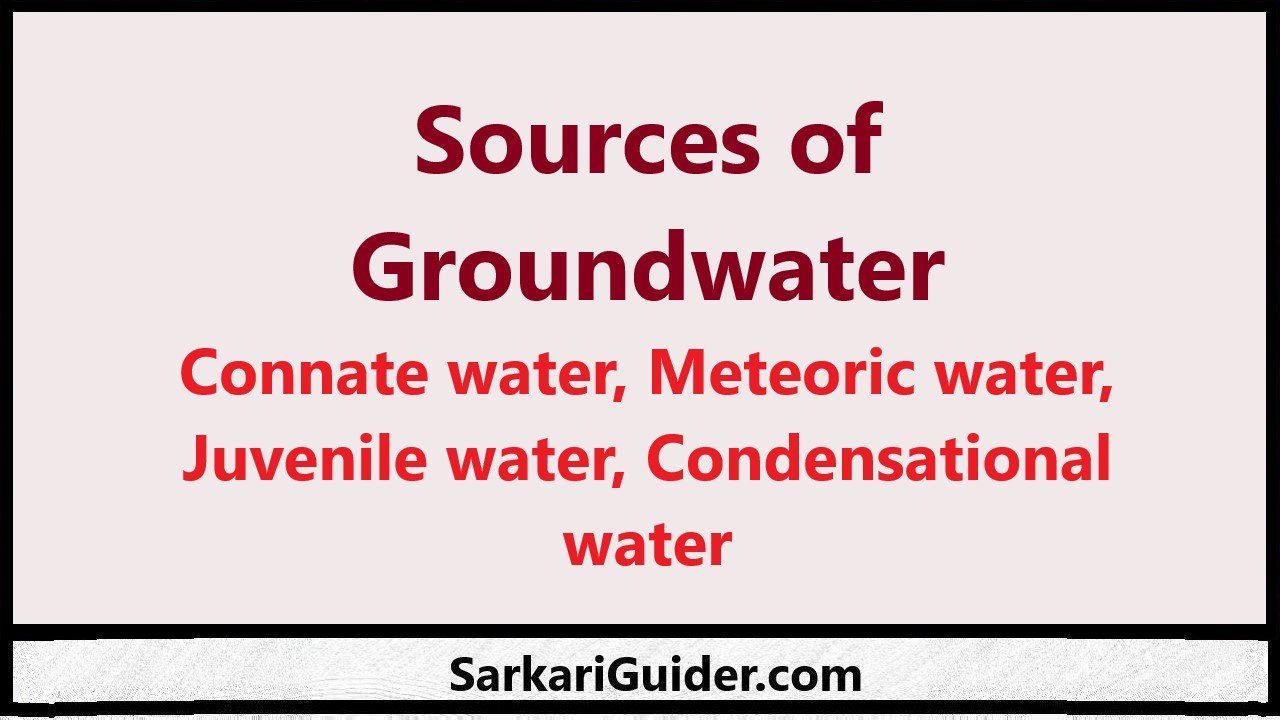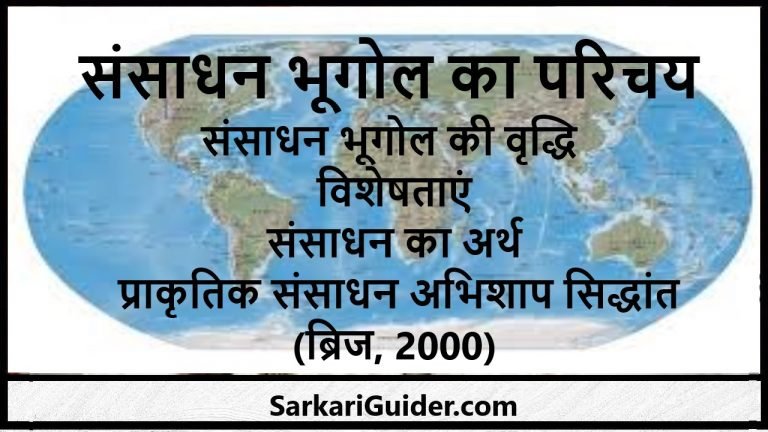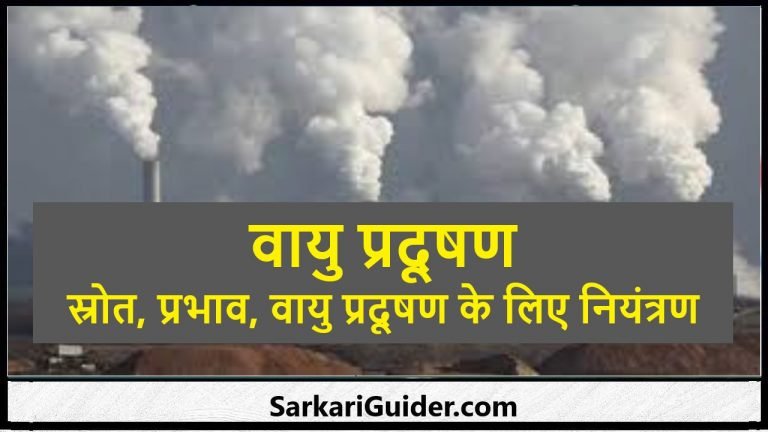Sources of Groundwater- Connate water, Meteoric water, Juvenile water, Condensational water

Sources of Groundwater– Connate water, Meteoric water, Juvenile water, Condensational water
There are four sources of groundwater:
(i) Connate water:
It is the water which includes in the rock itself, at the time of rock formation when water gets trapped in rock strata. Because rock containing connate water is typically formed from ocean sediments, it is normal saline. In geology and sedimentology, connate waters are liquid molecules which got trapped in the pores of sedimentary rocks at their time of deposition. These waters also contain many mineral components in the form of ions in solution. The connate liquids are expelled as rocks get buried and undergo lithification. If the escape route for these fluids blocks, the pore fluid pressure builds up in the rocks leading to overpressure.
(ii) Meteoric water:
It is the water which is derived from precipitation i.e. snow and rain. It includes water in lakes, rivers, and ice melts, which has fallen from precipitation indirectly. It originates in the atmosphere by evaporation which falls as rain and ultimately becomes groundwater by the process of infiltration. This infiltrating water continues its downward journey to the zone of saturation to become a part of the groundwater in aquifers, thus forming the major part of underground water.
(iii) Juvenile water:
It is also known as magmatic water as it originates in the earth’s interior and associates with the magmatic activities below the crust. Magmatic water rises from great depth accompanying magma intrusion. With the cooling of magma, its contents, gaseous and vapor etc. separate out from it. The water vapors gets condensed into heated water and gradually moves upward from the area of high temperature and pressure to that of low temperature and pressure. This is also called virgin water.
(iv) Condensational water:
It is the prime source which replenishes groundwater in deserts and semi-desert areas where precipitation is scanty, and there is rapid evaporation. During summers, the air over land is warmer than the air trapped in the soil, which lead to pressure difference between the two. Because of the pressure gradient, the atmospheric water vapor penetrates the rocks and gets converted into water through condensation due to falling temperature of the water vapor below. This process may lead to the accumulation of a certain amount of water in rocks in arid and desert regions.
महत्वपूर्ण लिंक
- भारतीय संविधान की विशेषताएँ
- जेट प्रवाह (Jet Streams)
- चट्टानों के प्रकार
- भारतीय जलवायु की प्रमुख विशेषताएँ (SALIENT FEATURES)
- राजा राममोहन राय की सम्पूर्ण जीवन यात्रा
- मृदा नमी को प्रभावित करने वाले कारक
- भूमिगत जल को प्रभावित करने वाले कारक
- परमाणु रिएक्टर का निर्माता एनरिको फर्मी
- भूमिगत जल के स्रोत
- वाष्पोत्सर्जन को प्रभावित करने वाले कारक
- मृदा नमी संरक्षण
- Important aspects related to the life of Netaji Subhash Chandra Bose
- Swami Dayanand Saraswati’s important contribution in social reform
- राजीव गांधी के व्यक्तित्व से जुड़े रोचक तथ्य
- Indian Citizenship
- अभिभावक शिक्षक संघ (PTA meeting in hindi)
- कम्प्यूटर का इतिहास (History of Computer)
- कम्प्यूटर की पीढ़ियाँ (Generations of Computer)
- कम्प्यूटर्स के प्रकार (Types of Computers )
- अमेरिका की क्रांति
- माया सभ्यता
- हरित क्रान्ति क्या है?
- हरित क्रान्ति की उपलब्धियां एवं विशेषताएं
- हरित क्रांति के दोष अथवा समस्याएं
- द्वितीय हरित क्रांति
- भारत की प्रमुख भाषाएँ और भाषा प्रदेश
- वनों के लाभ (Advantages of Forests)
- श्वेत क्रान्ति (White Revolution)
- ऊर्जा संकट
- प्रमुख गवर्नर जनरल एवं वायसराय के कार्यकाल की घटनाएँ
- INTRODUCTION TO COMMERCIAL ORGANISATIONS
- Parasitic Protozoa and Human Disease
- गतिक संतुलन संकल्पना Dynamic Equilibrium concept
- भूमण्डलीय ऊष्मन( Global Warming)|भूमंडलीय ऊष्मन द्वारा उत्पन्न समस्याएँ|भूमंडलीय ऊष्मन के कारक
- भूमंडलीकरण (वैश्वीकरण)
- मानव अधिवास तंत्र
- इंग्लॅण्ड की क्रांति
- प्राचीन भारतीय राजनीति की प्रमुख विशेषताएँ
- प्रथम अध्याय – प्रस्तावना
- द्वितीय अध्याय – प्रयागराज की भौगोलिक तथा सामाजिक स्थित
- तृतीय अध्याय – प्रयागराज के सांस्कृतिक विकास का कुम्भ मेल से संबंध
- चतुर्थ अध्याय – कुम्भ की ऐतिहासिक एवं सांस्कृतिक पृष्ठभूमि
- पंचम अध्याय – गंगा नदी का पर्यावरणीय प्रवाह और कुम्भ मेले के बीच का सम्बंध
Disclaimer: sarkariguider.com केवल शिक्षा के उद्देश्य और शिक्षा क्षेत्र के लिए बनाई गयी है | हम सिर्फ Internet पर पहले से उपलब्ध Link और Material provide करते है| यदि किसी भी तरह यह कानून का उल्लंघन करता है या कोई समस्या है तो Please हमे Mail करे- sarkariguider@gmail.com






